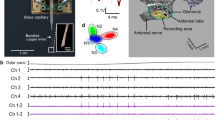Summary
-
1.
For the bushcricketTettigonia viridissima a portable recording unit was constructed which enabled long-term extracellular recordings of single and identified auditory nerve cells in the field. Thus, aspects of sound reception and of directional hearing could be studied in the animal's natural environment.
-
2.
The applicability of the technique is demonstrated in two examples. Remarkable hearing distances of 40–50 m were found in a grassland habitat; in denser bushland, these distances are reduced by about 20 m (Fig. 2). Once the stimulus is suprathreshold, the gross temporal structure of the song is well encoded in the activity of the omeganeuron even within a reflecting and scattering vegetation.
-
3.
By recording the activity of a pair of directionally-sensitive interneurons in the field we have direct experimental evidence that directional information is provided at remarkable communication distances and strongly depends on the spatial configuration between sender and receiver (Fig. 3).
Similar content being viewed by others
References
Autrum H (1960) Phasische und tonische Antworten vom Tympanalorgan vonTettigonia viridissima. Acustica 10:339–348
Griffin DR (1971) The importance of atmospheric attenuation for the echolocation of bats (Chiroptera). Anim Behav 19:55–61
Hill KG, Boyan GS (1977) Sensitivity to frequency and direction of sound in the auditory system of crickets (Gryllidae). J Comp Physiol 121:79–97
Kalmring K, Lewis B, Eichendorff A (1978) The physiological characteristics of the primary sensory neurons of the complex tibial organ ofDecticus verrucivorus L. (Orthoptera, Tettigoniidae). J Comp Physiol 127:109–121
Keuper A, Kühne R (1983) The acoustic behaviour of the bush-cricket,Tettigonia cantans: 2. Transmission of airborne sound and vibration signals in the biotope. Behav Proc 8:125–146
Michelsen A, Nocke H (1974) Biophysical aspects of sound communication in insects. Adv Insect Physiol 10:247–296
Michelsen A (1979) Insect ears as mechanical systems. Am Sci 67:696–706
Michelsen A, Larsen ON (1983) Strategies for acoustic communication in complex environments. In: Huber F, Markl H (eds) Neuroethology and behavioral physiology. Springer, Berlin Heidelberg New York Tokyo, pp 321–332
Popov AV, Shuvalov VF, Svetlogorskaya ID, Markovich AM (1974) Acoustic behaviour and auditory system in insects. In: Mechanoreception. Abh Rhein Westf Akad Wiss 53:281–306
Rheinlaender J (1975) Transmission of acoustic information at three neuronal levels in the auditory system ofDecticus verrucivorus (Tettigoniidae:Orthoptera). J Comp Physiol 97:1–55
Rheinlaender J, Römer H (1980) Bilateral coding of sound direction in the CNS of the bushcricketTettigonia viridissima L. (Orthoptera, Tettigoniidae). J Comp Physiol 140:101–111
Römer H (1985) Anatomical representation of frequency and intensity in the auditory system of Orthoptera. In: Kalmring K, Elsner N (eds) Acoustic and vibrational communication in insects. Paul Parey, Hamburg, pp 25–32
Suga N, Katsuki Y (1961) Central mechanisms of hearing in insects. J Exp Biol 38:545–558
Wiley RH, Richards DG (1978) Physical constraints on acoustic communication in the atmosphere: implications for the evolution of animal vocalizations. Behav Ecol Sociobiol 3:69–91
Author information
Authors and Affiliations
Rights and permissions
About this article
Cite this article
Rheinlaender, J., Römer, H. Insect hearing in the field. J. Comp. Physiol. 158, 647–651 (1986). https://doi.org/10.1007/BF00603821
Accepted:
Issue Date:
DOI: https://doi.org/10.1007/BF00603821




